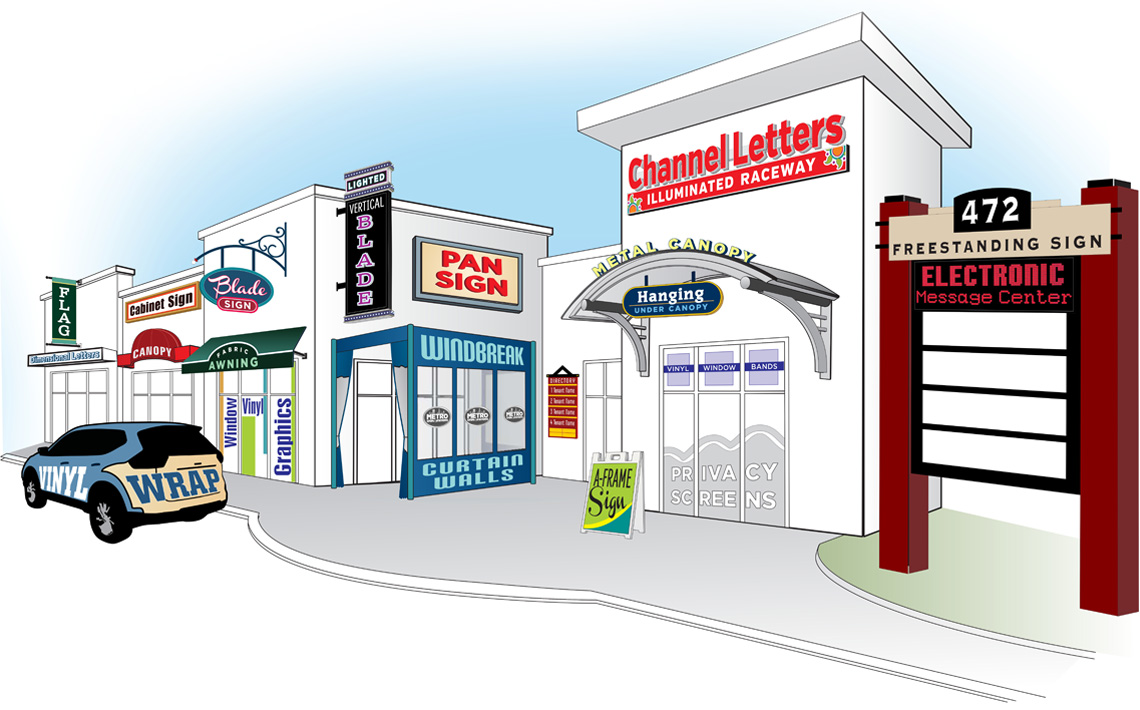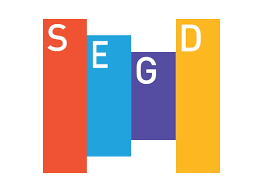9 Types of Business Signs and Services
Exterior Signage, Interior Signage, Original Posts, Signage TipsIf you’ve been looking into business signage, you might have found yourself bombarded with new terminology. Pylon, monument, blade… what’s the difference between all these types of signs?
Here are the standard options for exterior and interior business signs. We hope these pictures and descriptions help clear up any confusion. You can also use our interactive Educational Sign Type Tool to learn more.
Types of Exterior and Interior Business Signs
Pylon Signs
Pylon signs are the large, freestanding signs that are meant to be seen from a distance. They’re usually supported by one or two tall posts, and you’ve seen them used by gas stations, hotels, shopping centers, and restaurants along busy roads or highways. They can advertise a single business or several businesses.
Monument Signs
Monument signs are permanent free-standing signs that have a relatively low profile with a solid base. They’re usually constructed using materials such as aluminum, expanded polystyrene, high-density foam or masonry such as brick, concrete or rock. They’re a popular choice among residential complexes, upscale retail shopping centers, country clubs, churches, and corporate buildings.
Blade Signs
Blade signs are mounted above pedestrians’ heads, jutting out from the wall of a building. They may be illuminated or not. They are effective on city streets where vehicles or pedestrians may not have clear visibility to the wall-mounted sign. The projecting advertising allows potential customers to identify the business from some distance.
Awnings
Typically constructed with canvas, vinyl, ACM or aluminum over a frame, awnings hang over an entryway or storefront window. They provide noticeable signage along with promotion for the business. They keep you dry when there is rain and helps to reduce the snow build up on your walkway in front of the business.
As an added bonus, an awning can save you money in the hotter months by reducing your business’ air conditioning bills. Awnings have been found to reduce solar heat gain by up to 77%, depending on which direction your storefront window faces.
Window and Wall Graphics
Heavy-duty vinyl graphics can make an attention-grabbing impression as exterior or interior design elements. They can be applied to both windows and walls. It is an effective way to brand storefront windows or create innovative themed workspaces in a professional environment.
Directional and Wayfinding Signs
Directional signs help people find key locations within a complex or building. Some directional signs are placed outdoors to help pedestrians navigate an area.
Others, called wayfinding signs, are placed indoors to indicate conference rooms, offices, restrooms, stairways, elevators, and other destinations in a building. We see wayfinding signs as both an informational element and a branding opportunity since they can come together to provide an immersive experience.
ADA Signs
Many people refer to ADA signs as a separate category of signs, but in fact, they’re just wayfinding signs. The 1990 Americans with Disabilities Act placed federal regulations on most categories of wayfinding signs, and signs that comply with these laws are called “ADA compliant.”
Ensuring ADA compliance is a service that we include in with every relevant signage project. Many of our customers are pleasantly surprised to learn that ADA-compliant signs can support their brand in an aesthetically pleasing way. We’ve worked closely with the ADA Compliance Board to develop a full understanding of what is possible within ADA regulations.
Wall Signs
Hanging wall signs in many shapes and sizes, including embedded LED signs, non-illuminated letters, lighted sign boxes, and simple flat signs. They can be illuminated from within or from behind.
Banners
Usually made of vinyl with a longevity of three to five years, banners are flexible pieces of material that can be hung outdoors or indoors to advertise a business or event.
Sign Services You Need Before Posting a Sign
In a nutshell, you need to take three steps before you can install or post a sign: design, permitting, and fabrication. Before you can post a sign, you need a signage permit. Most municipalities require quite a bit of detail here, so you’ll want to get the sign designed before applying for a permit. Once you’ve got design specifications and a permit, you’ll need to get the sign fabricated to those specifications.
Sign Permitting
To ensure compliance with zoning and other local regulations, there is a permitting process for signs. On a standard permit application, you typically need to include:
- A dimensioned drawing of the proposed sign specifying all the dimensions (base size, total height, sign display area(s), etc).
- A copy of the site plan, specifying the location of the sign in relation to other architectural features and surrounding buildings
- Construction plans, illumination information, wiring diagrams, materials schedules, and other construction details
This varies by location, but we have experience working with various municipalities, and the expectations and processes are usually similar. Before you dive into the signage design process, consider looking into a supplier that offers design-build for a more streamlined experience that saves you time and money.
We hope you found this overview of signage types useful! If you’re looking to learn more about signs for your business, please get in touch.

